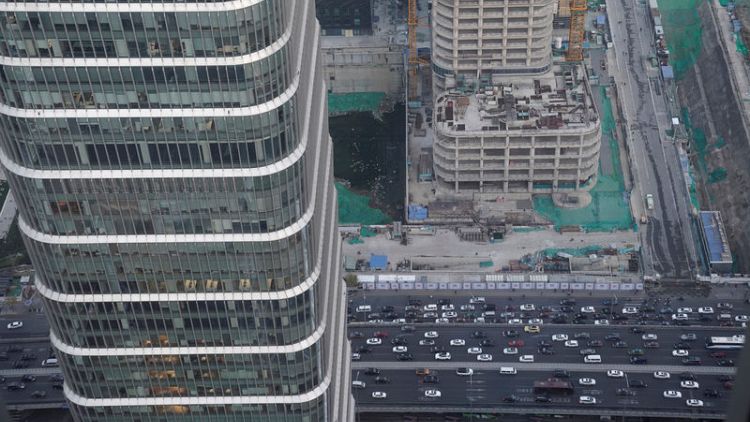SHANGHAI (Reuters) - China's bond market sold off sharply this week as a slew of unexpectedly strong economic indicators prompted investors to ask if country's latest round of monetary easing may be drawing to a close.
The first sign of trouble came when Chinese 10-year Treasury futures for June delivery, the most-traded contract, fell as much as 0.7 percent in initial deals on Monday.
While they recovered slightly by Tuesday afternoon, they were still down 0.6 percent from Friday's closing price.
The yield on benchmark 10-year government bonds has risen more than 7 basis points so far this week, according to Refinitiv data, the latest stage of a rout that has pushed the yield up around 33 basis points since the end of March.
At 3.40 percent, the 10-year yield has now retraced to levels last seen in December.
The latest selling pressure came after robust March credit data on Friday raised hopes that China's economy may be starting to stabilise.
Hit by a multi-year financial deleveraging campaign and the trade war with the United States, China's economic growth slowed to a near 30-year low of 6.6 percent in 2018.
Data due on Wednesday is expected to show the weakest first-quarter economic expansion in at least 27 years.
But March readings to be released at the same time (0200 GMT) are expected to show faster growth in industrial output, investment and retail sales, suggesting a flurry of policy support measures in recent months are starting to kick in.
"The stronger-than-expected credit expansion together with a rebound (in the) inflation reading reinforced market concerns that China may put easing monetary policy on hold," said Tommy Xie, head of Greater China Research at OCBC Bank in Singapore.
China's campaign to shore up slowing growth has seen it roll out billions of dollars worth of additional tax cuts and infrastructure spending this year.
That fiscal stimulus has been accompanied by five cuts to banks' reserve requirement ratio (RRR) over the past year as the People's Bank of China (PBOC) worked to encourage lending and reduce borrowing costs for small and private firms.
Economists polled by Reuters before Friday's credit data had expected three more RRR cuts this year in the current quarter and the next two, in line with previous surveys.
Many had pencilled in the next cut for this month, though Xie said after the strong lending data that there was no urgency to roll out more measures at the moment.
A summary of a quarterly meeting of the central bank's monetary policy committee published late on Monday suggested a more cautious approach.
The PBOC said it would maintain control of money supply "floodgates", a term absent from the previous quarter's statement.
"When the central bank reiterates risk prevention, the easing cycle of monetary policy might be ending," said Qu Qing, chief economist at Jianghai Securities.
The policy signal conveyed by the PBOC meeting suggested that tightening is on the way, and a near-term reduction in reserve requirement ratio (RRRs) or interest rates is unlikely, he said.
Nomura said in a note on Tuesday that there is much less room for easing and stimulus in China this time because of surging debt, but added it would be too early to start withdrawing easing measures as a sustainable recovery is still in question.
Still, expectations of tightening pushed benchmark five-year interest rate swaps (IRS) up to a high of 3.25 percent on Tuesday, up from 3.12 percent at last week's close.
Frances Cheung, head of macro strategy for Asia at Westpac in Singapore, also cautioned that any signs of a bottoming out in the economy were "preliminary".
"At this junction, policymakers would not want to suffocate growth and would not like to see funding costs materially higher," she said.
However, some traders and market watchers said that liquidity conditions were likely to tighten in mid-April as companies make first-quarter tax payments, boosting demand for cash and sucking funds out of the market.
Such liquidity concerns earlier this month had prompted some analysts to predict an imminent cut to banks' reserve requirements.
Iris Pang, an economist at ING in Hong Kong, said she maintains her expectation for an RRR cut this month.
"As trade war uncertainties linger on, there is a need to keep the fast yuan loan growth to help small private firms survive. An RRR cut is needed to facilitate fast credit growth," Pang said in a note.
"China may not need such fast ongoing credit injection into small private firms. That said, we believe that the central government will allow speedy credit growth to continue for some time, at least until it is satisfied that the job market is stable."
Investors looking for indications of a policy shift will be closely watching the PBOC's actions when medium-term lending facility (MLF) loans with a value of 366.5 billion yuan (£41.8 billion) expire on Wednesday.
A total of 1.1855 trillion yuan worth of the loans is due to mature in the second quarter, according to Reuters calculations based on official data.
(Reporting by Winni Zhou and Andrew Galbraith; Editing by Kim Coghill)



